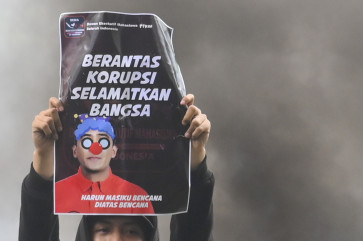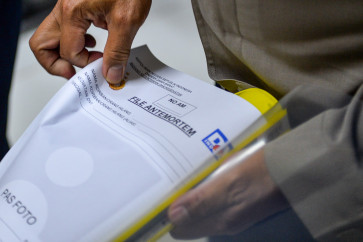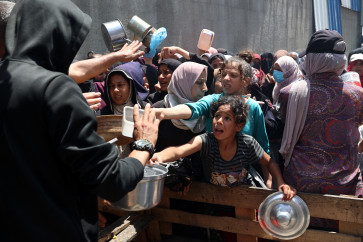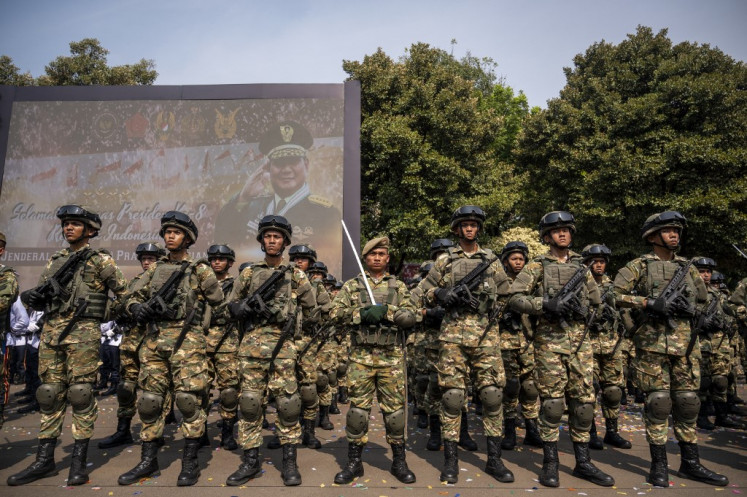Hariri assassination: The day that rocked Lebanon
Change text size
Gift Premium Articles
to Anyone
 A file photo taken on Feb. 13, 2012 shows billboards bearing portraits of Lebanese ex-premier Rafiq Hariri are pictured on the Sidon-Beirut highway in southern Lebanon on the eve of the anniversary of his assassination in 2005. - A massive bomb tore through Hariri's armoured convoy as he drove home for lunch on Valentine's Day 2005, killing him and 21 other people including seven of his bodyguards, as well as wounding 226 others. A UN-backed court is to deliver its judgement on Aug. 7, 2020, on four suspected Hezbollah members tried in absentia for former Lebanese premier Rafic Hariri's murder in a 2005 Beirut car bombing. (AFP/Mahmoud Zayyat )
A file photo taken on Feb. 13, 2012 shows billboards bearing portraits of Lebanese ex-premier Rafiq Hariri are pictured on the Sidon-Beirut highway in southern Lebanon on the eve of the anniversary of his assassination in 2005. - A massive bomb tore through Hariri's armoured convoy as he drove home for lunch on Valentine's Day 2005, killing him and 21 other people including seven of his bodyguards, as well as wounding 226 others. A UN-backed court is to deliver its judgement on Aug. 7, 2020, on four suspected Hezbollah members tried in absentia for former Lebanese premier Rafic Hariri's murder in a 2005 Beirut car bombing. (AFP/Mahmoud Zayyat )
T
he death of Rafic Hariri is to many Lebanese what the JFK assassination was to Americans four decades earlier -- everybody remembers what they were doing when the news broke.
On Valentine's Day 2005, the former prime minister who embodied the reconstruction of the country after its 1975-1990 civil war was killed in a monster bomb attack on his convoy.
The blast unleashed a ball of fire in the hotel quarter of downtown Beirut, shooting debris into the sky and shattering windows in a radius of nearly half a kilometer.
A suicide bomber in a white Mitsubishi truck packed with two tons of a potent military explosive called RDX had strategically positioned himself, waiting for Hariri's motorcade.
He detonated his charge at 12:55 pm, a split second after the passage of the third car in the convoy, a Mercedes S600 that Hariri was driving himself.
The whole of Beirut heard or felt the blast. Many thought an earthquake had struck. The smoldering crater dug by the explosion was 10 meters across.
One body was found 17 days after the blast, such was the devastation caused by the attack that left 226 people wounded.
The country soon found out that among the 22 dead was the man whose stature at home and abroad had earned him the nickname of "Mr Lebanon".
The unthinkable had just happened.
Hariri was no longer prime minister at the time but still very much the country's towering political figure and widely tipped to reclaim the job in upcoming polls.
The assassination was not entirely a surprise, however, and there had been warnings since Hariri had cast himself as the spearhead of a drive to end Syria's occupation of Lebanon.
Earlier in February that year, his friend then French president Jacques Chirac and then UN envoy Terje Roed-Larsen had implored Hariri to lay low.
Among other foreboding signs, his friend and former minister Marwan Hamade had narrowly survived a similar attack on his convoy in October 2004.
Fifteen years after the end of the civil war, Hariri's assassination became the watershed in Lebanon's post-conflict history.
The public backlash over his murder precipitated the departure of Syrian forces that had occupied the country for three decades.
That in turn gave Hezbollah, a key suspect in the assassination of the Sunni Muslim leader, a chance to grow and fill the vacuum.
The Shiite movement is an organization whose firepower rivals that of the Lebanese military and it has since evolved to also dominate the country's political life.
Some of the buildings left standing in the seaside area where the February 14 bomb went off still bear the marks of the explosion.
Hariri's supporters continue to visit the site, where a statue of the portly slain leader was erected.









